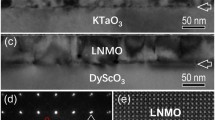Abstract.
Thin films of bismuth-layered perovskites such as SrBi2Ta2O9, Bi4Ti3O12, and BaBi4Ti4O15 with preferred orientations were grown by pulsed laser deposition on epitaxial conducting LaNiO3 electrodes on single-crystalline (100) SrTiO3 or on top of epitaxial buffer layers on (100) silicon. A morphology and structure investigation by X-ray diffraction analysis, scanning probe microscopy, and scanning and transmission electron microscopy showed that the films consisted of both c-axis-oriented regions and mixed (110)-, (100)-, and (001)-oriented regions. The regions with mixed orientation featured rectangular as well as equiaxed crystalline grains protruding out of a smooth c-oriented background. A closer examination revealed that the regions with mixed orientation actually consisted of a c-axis-oriented sublayer growing directly on the epitaxial LaNiO3 electrode, on top of which the growth of either (110)-, (100)-, or (001)-oriented grains took place. Macroscopic as well as microscopic measurements of the ferroelectric properties of regions with pure c-orientation and of regions with mixed orientations showed a clear relationship between their ferroelectric properties and their morphology and crystallographic orientation. In the regions with mixed orientation, the films exhibited saturated ferroelectric hysteresis loops with well-defined remnant polarisation Pr and coercive field Ec. The regions having c-axis orientation with a smooth surface morphology in contrast exhibited a linear P-E curve with no hysteretic behaviour for SrBi2Ta2O9 and BaBi4Ti4O15 and a weak ferroelectric behaviour for Bi4Ti3O12. This clearly showed that the ferroelectric properties of bismuth-layered ferroelectric oxides depended on the crystalline orientation of the film and that the observed ferroelectric hysteresis loops in SrBi2Ta2O9 and BaBi4Ti4O15 films were solely due to the (100)- and (110)-oriented grains. The size of the (110)- and (100)-oriented grains being of the order of 100 nm and spontaneous polarisation having been observed and switched in a controlled manner is a demonstration that ferroelectricity can exist in structures of submicrometer size. These results might have a technological impact due to the relevance of bismuth-layered ferroelectric oxides for the fabrication of non-volatile FeRAM memories.
Similar content being viewed by others
Author information
Authors and Affiliations
Additional information
Received: 5 August 1999 / Accepted: 16 August 1999 / Published online: 23 February 2000
Rights and permissions
About this article
Cite this article
Pignolet, A., Schäfer, C., Satyalakshmi, K. et al. Orientation dependence of ferroelectricity in pulsed-laser-deposited epitaxial bismuth-layered perovskite thin films . Appl Phys A 70, 283–291 (2000). https://doi.org/10.1007/s003390050048
Issue Date:
DOI: https://doi.org/10.1007/s003390050048




